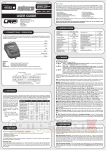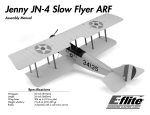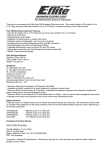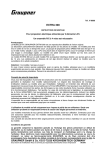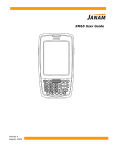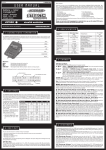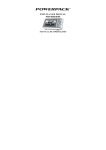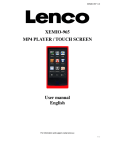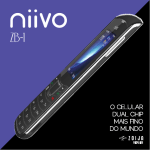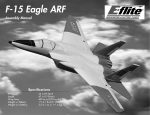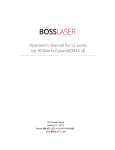Download Enticement_F3P - E
Transcript
Enticement F3P Profile
Assembly Manual
Specifications
Wingspan:
Length:
Wing Area:
Weight w/ Battery:
Weight w/o Battery:
34 in (860mm)
33 in (833mm)
245 sq in (15.5 sq dm)
5.0–5.75 oz (140–165 g)
4.0–5.0 oz (115–140 g)
Table of Contents
Specifications....................................................................... 1
Introduction.......................................................................... 2
Using the Manual................................................................. 3
Contents of Kit/Parts Layout.................................................. 3
Required Radio Equipment.................................................... 3
Important Information About Motor Selection......................... 4
Outrunner Setup (E-flite)....................................................... 4
Optional Accessories............................................................ 4
Required Tools and Adhesives............................................... 4
Notes Regarding Servos and ESC......................................... 5
Note on Lithium Polymer Batteries......................................... 5
Warning.............................................................................. 5
Warranty Period.................................................................. 5
Limited Warranty................................................................. 5
Damage Limits..................................................................... 6
Safety Precautions................................................................ 6
Questions, Assistance, and Repairs....................................... 6
Inspection or Repairs............................................................ 6
Warranty Inspection and Repairs.......................................... 6
Non-Warranty Repairs......................................................... 7
Safety, Precautions, and Warnings........................................ 7
Airframe Assembly............................................................... 8
Carbon Rod/Landing Gear Installation................................ 11
Servo Installation................................................................ 14
Motor Installation............................................................... 24
Final Assembly................................................................... 28
Control Throws................................................................... 31
Center of Gravity............................................................... 31
Range Test Your Radio........................................................ 32
Preflight............................................................................. 32
Flying Your Enticement........................................................ 33
2007 Official AMA
National Model Aircraft Safety Code........................ 34
Building and Flying Notes................................................... 35
2
Introduction
Thank you for purchasing the E-flite® Enticement F3P. The
Enticement is an attractive, easy-to-assemble flat foam
model, that offers incredible precision and aerobatic flight
characteristics. Constructed primarily of 3mm Depron foam, the
Enticement improves upon other similar designs in the market by
adding the stability and strength some other models lack. The
lightweight, laser-cut foam construction, carbon fiber support
rods and carbon fiber firewall set a new industry standard for
quality, durability and performance.
For anyone looking for an extremely lightweight, indoor foamie
that excels in precision aerobatic flight and is easy to assemble,
the Enticement is sure to tempt even the most steadfast RC pilot.
E-flite Enticement F3P Profile Assembly Manual
Using the Manual
This manual is divided into sections to help make assembly
easier to understand, and to provide breaks between each
major section. In addition, check boxes have been placed next
to each step to keep track of each step completed. Steps with
a single circle () are performed once, while steps with two
circles ( ) indicate that the step will require repeating, such
as for a right or left wing panel, two servos, etc.
Remember to take your time and follow the directions.
Contents of Kit/Parts Layout
Replacement Parts
EFL1176
EFL1177
EFL1178
EFL1179
EFL1180
EFL1181
Motor Mount/Firewall
Carbon Pushrod Set
Carbon Bracing and Landing Gear
Wheel Pants
Pushrod Supports (Wood)
Landing Skids, 2.5mm
E-flite Enticememt F3P Profile Assembly Manual
Required Radio Equipment
You will need a minimum 6-channel transmitter (for proper
mixing and dual rate capabilities), crystals, micro receiver,
and three sub-micro servos. You can choose to purchase a
complete radio system that includes all of these items or, if
you are using an existing transmitter, just purchase the other
required equipment separately. We recommend the crystal-free,
interference-free Spektrum™ DX7 2.4GHz DSM2™ 7-channel
system. If using your own transmitter, we recommend the use of
a JR SPORT™ 6-channel UltraLite receiver and E-flite® S60 Super
Sub-Micro servos for 72MHz users or the Nanolite 6-channel
flight pack for Spectrum users.
For Spectrum DX7 users
SPMAR6300F
DSM2 6CH Nanolite Flight Pack
For 72MHz users
JRPR610UL** R610UL 6CH FM, Shrinkwrap
FM Receiver (72MHz)
EFLRS60
6.0-Gram Super Sub-Micro Servo (3)
If you are using a Spectrum DX6
SPM6000AR6000 DSM 6-Channel Park
Flyer Receiver
EFLRS606.0-Gram Super Sub-Micro Servo (3)
3
Important Information About
Motor Selection
We recommend the E-flite® Park 250 Brushless Outrunner Motor
2200Kv (EFLM1130) to provide you with lightweight precision
F3P performance.
Outrunner Setup (E-flite)
EFLM1130Park 250 Brushless
Outrunner Motor, 2200Kv
EFLA1010
10-Amp Pro Brushless ESC
GWSEP8040B
8x4 Direct Drive Propeller
THP4802SJPL
480mAh 2-Cell 7.4V Li-Po, JST
EFLC3005
Celectra™ 1–3 Cell Li-Po Charger
4
Optional Accessories
EFLA110
Power Meter
Required Tools and Adhesives
Tools & Equipment
EFLA250
Park Flyer Tool Assortment, 5-piece
Or Purchase Separately
EFLA257Screwdriver, #0 Phillips (or included with
EFLA250)
Foam-safe CA
Foam-safe CA activator
Hot glue gun
Low-temperature hot glue
Hobby knife (#11 blade)
Ruler
Soldering iron
Straight edge
Square
Low-tack masking tape
E-flite Enticement F3P Profile Assembly Manual
Notes Regarding Servos and ESC
Limited Warranty
WARNING: Use of servos other than those we recommend may
overload the BEC of the recommended Electronic Speed Control
(ESC). We suggest the use of only the servos we recommend
when utilizing the recommended ESC’s BEC, or the use of a
separate BEC (like the UBEC) or receiver battery pack when
using other servos.
(a) This warranty is limited to the original Purchaser
("Purchaser") and is not transferable. REPAIR OR REPLACEMENT
AS PROVIDED UNDER THIS WARRANTY IS THE EXCLUSIVE
REMEDY OF THE PURCHASER. This warranty covers only those
Products purchased from an authorized Horizon dealer. Third
party transactions are not covered by this warranty. Proof of
purchase is required for warranty claims. Further, Horizon
reserves the right to change or modify this warranty without
notice and disclaims all other warranties, express or implied.
Note on Lithium Polymer Batteries
Lithium Polymer batteries are significantly more
volatile than alkaline or Ni-Cd/Ni-MH batteries used
in RC applications. All manufacturer’s instructions
and warnings must be followed closely. Mishandling
of Li-Po batteries can result in fire. Always follow the
manufacturer’s instructions when disposing of Lithium
Polymer batteries.
Warning
An RC aircraft is not a toy! If misused, it can cause serious
bodily harm and damage to property. Fly only in open areas,
preferably at AMA (Academy of Model Aeronautics) approved
flying sites, following all instructions included with your radio.
Keep loose items that can get entangled in the propeller away
from the prop, including loose clothing, or other objects such as
pencils and screwdrivers. Especially keep your hands away from
the propeller.
Warranty Period
(b) Limitations- HORIZON MAKES NO WARRANTY OR
REPRESENTATION, EXPRESS OR IMPLIED, ABOUT NONINFRINGEMENT, MERCHANTABILITY OR FITNESS FOR A
PARTICULAR PURPOSE OF THE PRODUCT. THE PURCHASER
ACKNOWLEDGES THAT THEY ALONE HAVE DETERMINED
THAT THE PRODUCT WILL SUITABLY MEET THE REQUIREMENTS
OF THE PURCHASER’S INTENDED USE.
(c) Purchaser Remedy- Horizon's sole obligation hereunder
shall be that Horizon will, at its option, (i) repair or (ii)
replace, any Product determined by Horizon to be defective.
In the event of a defect, these are the Purchaser's exclusive
remedies. Horizon reserves the right to inspect any and all
equipment involved in a warranty claim. Repair or replacement
decisions are at the sole discretion of Horizon. This warranty
does not cover cosmetic damage or damage due to acts of
God, accident, misuse, abuse, negligence, commercial use,
or modification of or to any part of the Product. This warranty
does not cover damage due to improper installation, operation,
maintenance, or attempted repair by anyone other than
Horizon. Return of any goods by Purchaser must be approved
in writing by Horizon before shipment.
Horizon Hobby, Inc., (Horizon) warranties that the Products
purchased (the “Product”) will be free from defects in materials
and workmanship at the date of purchase by the Purchaser.
E-flite Enticememt F3P Profile Assembly Manual
5
Damage Limits
Questions, Assistance, and Repairs
HORIZON SHALL NOT BE LIABLE FOR SPECIAL, INDIRECT
OR CONSEQUENTIAL DAMAGES, LOSS OF PROFITS OR
PRODUCTION OR COMMERCIAL LOSS IN ANY WAY
CONNECTED WITH THE PRODUCT, WHETHER SUCH CLAIM IS
BASED IN CONTRACT, WARRANTY, NEGLIGENCE, OR STRICT
LIABILITY. Further, in no event shall the liability of Horizon
exceed the individual price of the Product on which liability
is asserted. As Horizon has no control over use, setup, final
assembly, modification or misuse, no liability shall be assumed
nor accepted for any resulting damage or injury. By the act of
use, setup or assembly, the user accepts all resulting liability.
Your local hobby store and/or place of purchase cannot provide
warranty support or repair. Once assembly, setup or use of the
Product has been started, you must contact Horizon directly.
This will enable Horizon to better answer your questions and
service you in the event that you may need any assistance.
For questions or assistance, please direct your email to
[email protected], or call 877.504.0233 toll
free to speak to a service technician.
If you as the Purchaser or user are not prepared to accept the
liability associated with the use of this Product, you are advised
to return this Product immediately in new and unused condition
to the place of purchase.
Law: These Terms are governed by Illinois law (without regard to
conflict of law principals).
Safety Precautions
This is a sophisticated hobby Product and not a toy. It must be
operated with caution and common sense and requires some
basic mechanical ability. Failure to operate this Product in a safe
and responsible manner could result in injury or damage to the
Product or other property. This Product is not intended for use
by children without direct adult supervision. The Product manual
contains instructions for safety, operation and maintenance. It is
essential to read and follow all the instructions and warnings in
the manual, prior to assembly, setup or use, in order to operate
correctly and avoid damage or injury.
6
Inspection or Repairs
If this Product needs to be inspected or repaired, please call for
a Return Merchandise Authorization (RMA). Pack the Product
securely using a shipping carton. Please note that original boxes
may be included, but are not designed to withstand the rigors
of shipping without additional protection. Ship via a carrier that
provides tracking and insurance for lost or damaged parcels, as
Horizon is not responsible for merchandise until it arrives and
is accepted at our facility. A Service Repair Request is available
at www.horizonhobby.com on the “Support” tab. If you do not
have internet access, please include a letter with your complete
name, street address, email address and phone number where
you can be reached during business days, your RMA number,
a list of the included items, method of payment for any nonwarranty expenses and a brief summary of the problem.
Your original sales receipt must also be included for warranty
consideration. Be sure your name, address, and RMA number
are clearly written on the outside of the shipping carton.
Warranty Inspection and Repairs
To receive warranty service, you must include your original
sales receipt verifying the proof-of-purchase date. Provided
warranty conditions have been met, your Product will be
repaired or replaced free of charge. Repair or replacement
decisions are at the sole discretion of Horizon Hobby.
E-flite Enticement F3P Profile Assembly Manual
Non-Warranty Repairs
Should your repair not be covered by warranty the repair
will be completed and payment will be required without
notification or estimate of the expense unless the expense
exceeds 50% of the retail purchase cost. By submitting the item
for repair you are agreeing to payment of the repair without
notification. Repair estimates are available upon request. You
must include this request with your repair. Non-warranty repair
estimates will be billed a minimum of ½ hour of labor. In
addition you will be billed for return freight. Please advise us
of your preferred method of payment. Horizon accepts money
orders and cashiers checks, as well as Visa, MasterCard,
American Express, and Discover cards. If you choose to pay
by credit card, please include your credit card number and
expiration date. Any repair left unpaid or unclaimed after 90
days will be considered abandoned and will be disposed of
accordingly. Please note: non-warranty repair is only available
on electronics and model engines.
Electronics and engines requiring inspection or repair should be
shipped to the following address:
Horizon Service Center
4105 Fieldstone Road
Champaign, Illinois 61822
All other Products requiring warranty inspection or repair should
be shipped to the following address:
Horizon Product Support
4105 Fieldstone Road
Champaign, Illinois 61822
Safety, Precautions, and Warnings
As the user of this product, you are solely responsible for
operating it in a manner that does not endanger yourself
and others or result in damage to the product or the property
of others.
Carefully follow the directions and warnings for this and any
optional support equipment (chargers, rechargeable battery
packs, etc.) that you use.
This model is controlled by a radio signal that is subject to
interference from many sources outside your control. This
interference can cause momentary loss of control so it is
necessary to always keep a safe distance in all directions
around your model, as this margin will help to avoid collisions
or injury.
•A
lways operate your model in an open area away from cars,
traffic, or people.
•A
void operating your model in the street where injury or
damage can occur.
•N
ever operate the model out into the street or populated
areas for any reason.
• Never operate your model with low transmitter batteries.
•C
arefully follow the directions and warnings for this and any
optional support equipment (chargers, rechargeable battery
packs, etc.) that you use.
•K
eep all chemicals, small parts and anything electrical out of
the reach of children.
•M
oisture causes damage to electronics. Avoid water exposure
to all equipment not specifically designed and protected for
this purpose.
Please call 877-504-0233 with any questions or concerns
regarding this product or warranty.
E-flite Enticememt F3P Profile Assembly Manual
7
Airframe Assembly
Required Parts
Vertical fuselage
Foam firewall
Top fuselage stiffener (2)
Bottom fuselage stiffener (2)
Stabilizer/rear horizontal fuselage
Main wing/front horizontal fuselage
Required Tools and Adhesives
Foam-safe CA
Foam-safe CA activator
Low tack tape
1. Place a piece of waxed paper or the packaging from
your model onto your work surface. With the main wing
resting on the waxed paper, slide the rear horizontal
fuselage in position. Use a straight edge to check the
alignment of the two pieces, aligning the holes in the
center of each. (Make sure the top of both fuse pieces
are facing up.) Use foam-safe CA to glue the two pieces
together. Allow the CA to fully cure before proceeding.
Square
Straight edge
Note: Although it is easy to build your Enticement, it
is also easy to build it crooked. Take your time with
each step and check the alignment of the model as you
progress. A straight model will perform much better than
one that is not.
8
E-flite Enticement F3P Profile Assembly Manual
2. Slide the horizontal fuselage into the vertical fuselage,
nose first. You will need to fold the elevator up onto the
stabilizer and bend the horizontal fuselage slightly to fit it
into the vertical fuselage.
E-flite Enticememt F3P Profile Assembly Manual
3. Flip the elevator back into its correct position and align
the tabs from the vertical fuselage into the slots in the
horizontal fuselage. Do not glue the vertical fuse to the
horizontal fuse at this time.
4. Position the foam firewall at the front of the fuselage.
The vertical and horizontal fuselage pieces will fit tight
against the firewall. Use foam-safe CA to glue the foam
firewall to the vertical and horizontal fuselage.
9
5. Use a square and foam-safe CA to glue the vertical
and horizontal fuselage pieces together. Start at the
front and slowly work your way toward the rear of the
fuselage, gluing small sections at a time.
6. Locate the top fuselage stiffeners Note the positioning
of the stiffener in the following photos. Glue the stiffener
to the top edge of the foam firewall to start. Again,
work slowly, gluing the stiffener to the fuselage pieces.
The stiffener is positioned at a 45-degree angle to each:
position it equally on both fuselage pieces.
Note: Use low-tack tape to tape the control surfaces in
their neutral positions. This will make the airframe easier
to handle during assembly. Be careful not to tape the
printed surfaces as there is a chance of the printing
coming off when removing the tape.
10
E-flite Enticement F3P Profile Assembly Manual
7. Locate the bottom fuselage stiffeners Note the
positioning of the stiffener in the following photo.
Glue the stiffener to the top edge of the foam firewall
to start. Glue the stiffener to the fuselage pieces using
foam-safe CA.
Carbon Rod/Landing Gear Installation
Required Parts
Assembled airframe
Molded skid (2)
1 5/8-inch (41mm) carbon rod (2)
5 5/8-inch (144mm) carbon rod (2)
10 3/4-inch (274mm) carbon rod (2)
11 1/2-inch (294mm) carbon rod (2)
3/32 x 6 7/8-inch (2.5mm x 175mm) landing gear strut (2)
Required Tools and Adhesives
Foam-safe CA
Hobby knife
Foam-safe CA activator
Square
Note: You must take extra care in this section to
maintain the alignment of your airframe and to not
build in any unwanted twists in the airframe. Make
sure to keep everything aligned and the wing straight
with the fuselage. Also make sure not to induce any
twist in the wing, which could adversely affect the flight
characteristics of your aircraft.
E-flite Enticememt F3P Profile Assembly Manual
1. Use a hobby knife to remove the hinge tape covering
the slots for the carbon rods along the aileron hinge line
on both the left and right wing panels.
11
m 2. Locate the 10 3/4-inch (274mm) carbon rod. Position
the rod from the slot near the leading edge of the wing to
the rear position on the vertical fuselage. Glue ONLY the
position at the wing at this time. The carbon will protrude
out of the top of the wing for all struts about 1–2mm.
4. Repeat Steps 2 and 3 for the opposite wing panel.
5. Check the alignment of the wing to the fuselage to
make sure the wing is not twisted and is parallel to the
work surface. Use foam-safe CA to glue the carbon rods
to the vertical fuselage once the alignment has been
checked thoroughly.
6. Locate the two 1 5/8-inch (41mm) carbon rods. Position
the rod in the wing flush with the top of the wing.
Align the carbon rod at the "V" intersection nearest the
fuselage of the carbon wing rods. Use foam-safe CA
to glue the 1 5/8-inch (41mm) carbon rods to the wing
and the intersection of the carbon rods. The support rod
should be perpendicular to the wing.
m 3. Locate the 11 1/2-inch (294mm) carbon rod. Position
the rod from the slot near the aileron hinge line of the
wing to the forward position on the vertical fuselage.
Glue ONLY the position at the wing at this time.
12
E-flite Enticement F3P Profile Assembly Manual
7. Locate the two 5 5/8-inch (144mm) carbon rods.
Insert the carbon rods between the vertical fin and
horizontal stabilizer. Glue the rods at the fin ONLY
using foam-safe CA, then use a square to check to
make sure the fin is square to the stabilizer. Once the
fin and stabilizer are square, use foam-safe CA to glue
the carbon rods to the stabilizer.
E-flite Enticememt F3P Profile Assembly Manual
8. Locate the two 3/32 x 6 7/8-inch (2.5mm x 175mm)
landing gear struts. Use foam-safe CA to glue the molded
skids to the struts.
13
14
9. Slide the struts through the fuselage and into the slot
in the wing. Allow about 3/32-inch (2.5mm) of the strut
protruding above the top of the wing.
10. Align the skids so they are parallel to the horizontal
fuselage and use foam-safe CA to glue the landing gear
to the vertical fuselage and wing.
E-flite Enticement F3P Profile Assembly Manual
Servo Installation
Required Parts
Airframe assembly
Control horn support (3)
Rudder control horn support Heat-shrink tubing (4)
1/16 x 13/16-inch (2mm x 20mm) carbon control horn (4)
4-inch (103mm) carbon pushrods (2)
14 7/16-inch (370mm) carbon pushrod (1)
15 5/8-inch (398mm) carbon pushrod (1)
Plywood pushrod supports (4)
Required Tools and Adhesives
Foam-safe CA
Low-temperature hot glue
Soldering iron
1. Use a ruler to measure 9/16-inch (15mm) on each
of the four 1/16 x 13/16-inch (2mm x 20mm) carbon
control horns. Use foam-safe CA to glue each of the
control horn supports to the rods with the bottom edge
of the support 9/16-inch (15mm) from the top of the
control horn.
Foam-safe CA activator
Hot glue gun
Hobby knife
Note: The rudder control horn support is longer than the
aileron and elevator supports. This longer edge faces
away from the control horn as shown in the photo.
E-flite Enticememt F3P Profile Assembly Manual
15
16
2. Use foam-safe CA to glue the control horns to the
ailerons and elevator. Make sure to remove any hinge
tape using a hobby knife so the support is glued
directly to the foam. All control horn supports should be
perpendicular to the hinge line.
3. Use foam-safe CA to glue the rudder control horn
to the rudder. The horn will be on the side opposite the
elevator control horn. Again, remove any hinge tape so
the horn is glued securely to the rudder.
E-flite Enticement F3P Profile Assembly Manual
4. Plug the servos into the radio system and make sure
they operate and are centered as well. Also center the
trims on the transmitter at this time. If you are using a
computer radio, start with a clear model program and
check that all sub trims are set to 0 and all throws are set
to 100%. Prepare the servos for installation by attaching
the long 3D arms on the servos and by removing any
unnecessary arms from the elevator and rudder servo
horns as shown.
WARNING: The next step will void your servo warranty!
Hint: If you really want to lighten up the Enticement there
are a few things that can be done.
These next steps will net almost 3 grams in savings.
You will need extra 1mm carbon rod and extra heat shrink
tubing to complete the following steps.
A.
Take the case off of the bottom of the S60 servo.
You can also eliminate the servo control horn by using
a piece 1mm carbon rod cut to the correct length. This
must be done with great caution.
C.
E-flite Enticememt F3P Profile Assembly Manual
Center the servo using the radio system as described
in Step 4.
17
18
D.
Carefully drill out the servo spline at the correct angle for
the carbon rod.
E.
Insert the carbon rod and glue it to the spline. (Do this
with extreme caution!) The easiest way that we have
found is to turn the servo upside down (spline down)
and use thin CA that has been put on the end of a
hobby knife blade.
The following images show the servos installed with the
previous modifications.
E-flite Enticement F3P Profile Assembly Manual
E-flite Enticememt F3P Profile Assembly Manual
5. Use low-temperature hot glue to secure the servos in
the fuselage. All the output arms for the servos will face
the front of the aircraft.
19
20
6. Use hook and loop tape to attach the receiver to the
fuselage. Use clear tape to secure the servo leads to the
fuselage so they will not interfere with the operation of
the linkage in flight. Also plug the adapter for the speed
control into the receiver at this time if necessary.
m 7. Attach the Z-bend from the 4-inch (103mm) carbon
pushrods to the outer holes of the aileron servo arm.
E-flite Enticement F3P Profile Assembly Manual
mmm 8. With the ailerons and aileron servo centered,
check the distance between the horns and pushrods.
There should be a 1/16-inch (1mm) gap between them.
If not, use side cutters to trim the pushrods to the correct
length.
mmm 9. Slide the heat shrink tubing on the control horns,
then slide the pushrods into the heat shrink, centering
the heat shrink between the two. Use a soldering iron to
shrink the tubing onto the control horns and pushrods for
both ailerons.
Note: You must use a soldering iron to shrink the tubing.
The heat from other methods cannot be controlled as well
and will cause damage to your airframe.
E-flite Enticememt F3P Profile Assembly Manual
10. Repeat Steps 7 though 9 for the opposite aileron
pushrod installation.
21
22
m 11. Slide the two supports onto the 15 5/8-inch (398mm)
rudder pushrod.
m 13. Repeat Steps 8 and 9 to attach the pushrod to the
control horn.
m 12. Attach the Z-bend from the pushrod to the
rudder servo.
m 14. Use foam-safe CA to glue the pushrod supports in
the notches in the fuselage. Make sure to position the
supports so they do not bind the pushrod when operating
the rudder.
E-flite Enticement F3P Profile Assembly Manual
m
15. The installation of the 14 7/16-inch (366mm) elevator
pushrod is identical to that of the rudder pushrod. Repeat
Steps 8 through 14 to install the elevator pushrod.
m
E-flite Enticememt F3P Profile Assembly Manual
16. Once all the pushrods have been installed, remove
the low-tack tape holding the control surfaces centered
and check the operation of your radio system.
23
Motor Installation
Required Parts
Assembled airframe
Motor w/hardware
Propeller
Motor battery
Required Tools and Adhesives
Foam-safe CA
Hobby knife
24
2. Use a hobby knife to remove the foam from the
firewall in the location for the motor leads and in the
center of the firewall as well.
3. Attach the motor mount to the firewall using the
hardware provided with the motor and a #0 Phillips
screwdriver.
Carbon firewall
Speed control
Hook and loop tape
Foam-safe CA activator
Phillips screwdriver: #0
1. Use foam-safe CA to attach the firewall to the
fuselage. The opening for the motor leads is on the
left-hand side of the aircraft from the pilots perspective
toward the bottom. (Make sure to locate the firewall as
pictured below.)
E-flite Enticement F3P Profile Assembly Manual
4. Pass the motor leads through the hole in the firewall.
Attach the speed control to the leads at this time.
E-flite Enticememt F3P Profile Assembly Manual
5. Attach the motor to the motor mount using the
hardware provided with the motor.
25
WARNING: The next step will void your ESC warranty!
This is only necessary to remove additional weight from
your airframe.
7. Attach the battery to the fuselage using hook and
loop tape.
Remove the heat shrink from the ESC will also help to
reduce the weight of the airframe.
26
6. Carefully secure the speed control in the "pocket"
created by the bottom fuselage stiffener using hook and
loop tape.
E-flite Enticement F3P Profile Assembly Manual
Important Information About Your Brushless ESC
Make sure your ESC brake is programmed to Off. Also,
be sure to use an ESC with the proper low-voltage cutoff
and it is set correctly for the batteries you are using.
8. Turn on the radio system and plug the battery into the
speed control. Use the throttle to check that the motor
rotates counterclockwise when viewed from the front. If
not, follow the directions included with your speed control
to change the direction of the motor rotation.
Note: Never check the motor rotation on the bench
with the propeller installed. The plane could move and
cause serious injury. Always check the motor without the
propeller to avoid injury.
E-flite Enticememt F3P Profile Assembly Manual
Important Information About Your Propeller
It is also very important to check to be sure the
propeller is balanced before installing onto the shaft. An
unbalanced propeller may strip the gears or cause poor
flight characteristics.
Note: If it is necessary to enlarge the hole in the
propeller, make sure to check the balance of the
propeller afterwards.
9. Install the adapter (included with the motor) or drill the
propeller as necessary to fit your particular motor.
27
10. Attach the propeller to the motor following the
instructions provided with the motor.
Final Assembly
Required Parts
Assembled airframe
Side force generator (4)
Drag brake (2)
Wheel pant (2)
1
3 /8-inch (80mm) carbon rod (4)
2-inch (50mm) carbon rod (2)
Required Tools and Adhesives
Foam-safe CA
Square
28
Foam-safe CA activator
Ruler
1. The side force generators are positioned on the wing,
aligned with the two holes near the wing tip. Use foamsafe CA and a square to glue the side force generators to
the top and bottom of the wing.
E-flite Enticement F3P Profile Assembly Manual
2. Position a 3 1/8-inch (80mm) carbon rod between
the wing and each of the side force generators. Use
foam-safe CA to glue the carbon rods to the wing.
Double-check the alignment to make sure the side force
generators are square to the wing; then use foam-safe
CA to glue the carbon rods to the generators.
E-flite Enticememt F3P Profile Assembly Manual
3. Measure and mark the center (top to bottom) of the
drag brake.
4. Use foam-safe CA to glue the drag brakes to the
trailing edge of the aileron using the notches in the
aileron as guides. Also make sure the drag brake is
square to the aileron as shown.
29
30
5. Position a 2-inch (50mm) carbon rod between the
bottom of the aileron and each of the drag brakes. Use
foam-safe CA to glue the carbon rods to the aileron.
Double-check the alignment to make sure the drag brakes
are square to the aileron, then use foam-safe CA to glue
the carbon rods to the drag brakes.
6. At this time it is suggested to go back and check all
the glue joints to make sure they are solid. Apply foamsafe CA to any areas that may need a little extra glue.
7. Use foam-safe CA to glue the foam wheel pant onto
the molded skid. Use the notch in the wheel pant to
center it on the skid.
E-flite Enticement F3P Profile Assembly Manual
Control Throws
1
. Turn on the transmitter and receiver of your Enticement.
Check the movement of the rudder using the transmitter.
When the stick is moved right, the rudder should also move
right. Reverse the direction of the servo at the transmitter if
necessary.
2
. Check the movement of the elevator with the radio system.
Moving the elevator stick down will make the airplane
elevator move up.
Center of Gravity
An important part of preparing the aircraft for flight is properly
balancing the model.
Caution: Do not inadvertently skip this step!
The recommended Center of Gravity (CG) location for the
Enticement is 3.35–3.55 inches (85–90mm) behind the leading
edge of the wing at the center.
3
. Check the movement of the ailerons with the radio system.
Moving the aileron stick right will make the right aileron
move up and the left aileron move down.
4
. Use a ruler to adjust the throw of the elevator, ailerons
and rudder. Adjust the position of the pushrod at the control
horn to achieve the following measurements when moving the
sticks to their endpoints.
Note: Measurements are taken at the widest point on
the surface.
Ailerons
Low Rate: 1 1/4-inch (35mm) with 25% Expo (Up/Down)
HIgh Rate:2-inch (50mm) with 40% Expo (Up/Down)
Elevator
Low Rate: 1-inch (25mm) with 20% Expo (Up/Down)
After the first flights, the CG position can be adjusted for your
personal preference.
High Rate:1 1/2-inch (40mm) with 45% Expo (Up/Down)
Rudder
Low Rate: 1 1/2-inch (40mm) with 30% Expo (Left/Right)
High Rate:2 3/4-inch (70mm) with 50% Expo (Left/Right)
These are general guidelines measured from our own flight tests.
You can experiment with higher rates to match your preferred
style of flying.
E-flite Enticememt F3P Profile Assembly Manual
31
Range Test Your Radio
1
. Before each flying session, be sure to range check your
radio. This is accomplished by turning on your transmitter
with the antenna collapsed. Turn on the receiver in your
airplane. With your airplane on the ground and the
engine running, you should be able to walk 30 paces
(approximately 100 feet) away from your airplane and still
have complete control of all functions.
If not, don’t attempt to fly! Have your radio equipment
checked out by the manufacturer.
2
. Double-check that all controls (aileron, elevator, rudder
and throttle) move in the correct direction.
3
. Be sure that your transmitter batteries are fully charged,
per the instructions included with your radio.
Preflight
Check Your Radio
Before going to the field, be sure that your batteries are fully
charged per the instructions included with your radio. Charge
both the transmitter and receiver pack for your airplane. Use
the recommended charger supplied with your particular radio
system, following the instructions provided with the radio. In
most cases, the radio should be charged the night before going
out flying.
Before each flying session, be sure to range check your radio.
See your radio manual for the recommended range and
instructions for your radio system. Each radio manufacturer
specifies different procedures for their radio systems. Next, start
the motor. With the model securely anchored, check the range
again. The range test should not be significantly affected. If it is,
don’t attempt to fly! Have your radio equipment checked out by
the manufacturer.
Note: Keep loose items that can get entangled in
the propeller away from the prop. These include
loose clothing, or other objects such as pencils and
screwdrivers. Especially keep your hands away from the
propeller.
Double-check that all controls (aileron, elevator, rudder and
throttle) move in the correct direction.
Check the radio installation and make sure all the control
surfaces are moving correctly (i.e. the correct direction and with
the recommended throws). Test run the motor and make sure
it transitions smoothly from off to full throttle and back. Also
ensure the engine is installed according to the manufacturer’s
instructions, and it will operate consistently.
Check all the control horns, servo horns, and clevises to make
sure they are secure and in good condition. Replace any items
that would be considered questionable. Failure of any of these
components in flight would mean the loss of your aircraft.
32
E-flite Enticement F3P Profile Assembly Manual
Flying Your Enticement
Flying the Enticement is about as fun as it can get. Very light
wing loading and extreme control throws make for some precise
F3P flying. Verify that your CG is at the correct location as per
the manual and that you have your rates set up to your liking.
Verify all control throws are in the correct direction and the
motor spins in the correct direction as well.
Point the model into the wind and add some throttle trim until
the motor begins to turn. This will be your flight idle. Now,
apply power slowly. You will find the model will become
airborne very quickly and at a low speed. This model excels
at flying slow and easy as well as fast and extreme. Trim the
model for level flight at half throttle. Only use full throttle for
maneuvering.
You will find you can adjust the CG to your liking by moving the
battery pack fore or aft on the fuselage.
To land the Enticement just reduce the throttle to idle and feed in
up elevator until the model settles into a slightly nose-high attitude.
Gently fly the model down to the landing spot with a final flair at
touchdown. You will find the model will have a very short roll out.
We hope you enjoy the Enticement as much as we do.
Happy landings.
E-flite Enticememt F3P Profile Assembly Manual
33
2007 Official AMA National
Model Aircraft Safety Code
GENERAL
1) I will not fly my model aircraft in sanctioned events, air shows
or model flying demonstrations until it has been proven to be
airworthy by having been previously, successfully flight tested.
2) I will not fly my model higher than approximately 400 feet within 3
miles of an airport without notifying the airport operator. I will give
right-of-way and avoid flying in the proximity of full-scale aircraft.
Where necessary, an observer shall be utilized to supervise flying
to avoid having models fly in the proximity of full-scale aircraft.
3) Where established, I will abide by the safety rules for the flying
site I use, and I will not willfully or deliberately fly my models in a
careless, reckless and/or dangerous manner.
4) The maximum takeoff weight of a model is 55 pounds, except
models flown under Experimental Aircraft rules.
5) I will not fly my model unless it is identified with my name and
address or AMA number on or in the model. (This does not apply
to models while being flown indoors.)
6) I will not operate models with metal-bladed propellers or with
gaseous boosts, in which gases other than air enter their internal
combustion engine(s); nor will I operate models with extremely
hazardous fuels such as those containing tetranitromethane or
hydrazine.
RADIO CONTROL
1) I will have completed a successful radio equipment ground range
check before the first flight of a new or repaired model.
2) I will not fly my model aircraft in the presence of spectators until I
become a qualified flier, unless assisted by an experienced helper.
3) At all flying sites a straight or curved line(s) must be established
in front of which all flying takes place with the other side for
spectators. Only personnel involved with flying the aircraft are
allowed at or in front of the flight line. Intentional flying behind the
flight line is prohibited.
34
4) I will operate my model using only radio control frequencies
currently allowed by the Federal Communications Commission.
(Only properly licensed Amateurs are authorized to operate
equipment on Amateur Band frequencies.)
5) Flying sites separated by three miles or more are considered safe
from site-to-site interference, even when both sites use the same
frequencies. Any circumstances under three miles separation
require a frequency management arrangement, which may be
either an allocation of specific frequencies for each site or testing
to determine that freedom from interference exists. Allocation plans
or interference test reports shall be signed by the parties involved
and provided to AMA Headquarters.
Documents of agreement and reports may exist between (1) two
or more AMA Chartered Clubs, (2) AMA clubs and individual
AMA members not associated with AMA Clubs, or (3) two or
more individual AMA members.
6) For Combat, distance between combat engagement line
and spectator line will be 500 feet per cubic inch of engine
displacement. (Example: .40 engine = 200 feet.); electric motors
will be based on equivalent combustion engine size. Additional
safety requirements will be per the RC Combat section of the
current Competition Regulations.
7) At air shows or model flying demonstrations, a single straight line
must be established, one side of which is for flying, with the other
side for spectators.
8) With the exception of events flown under AMA Competition rules,
after launch, except for pilots or helpers being used, no powered
model may be flown closer than 25 feet to any person.
9) Under no circumstances may a pilot or other person touch a
powered model in flight.
E-flite Enticement F3P Profile Assembly Manual
Building and Flying Notes
E-flite Enticememt F3P Profile Assembly Manual
35
© 2007 Horizon Hobby, Inc.
4105 Fieldstone Road
Champaign, Illinois 61822
(877) 504-0233
11235
horizonhobby.com
E-fliteRC.com





































